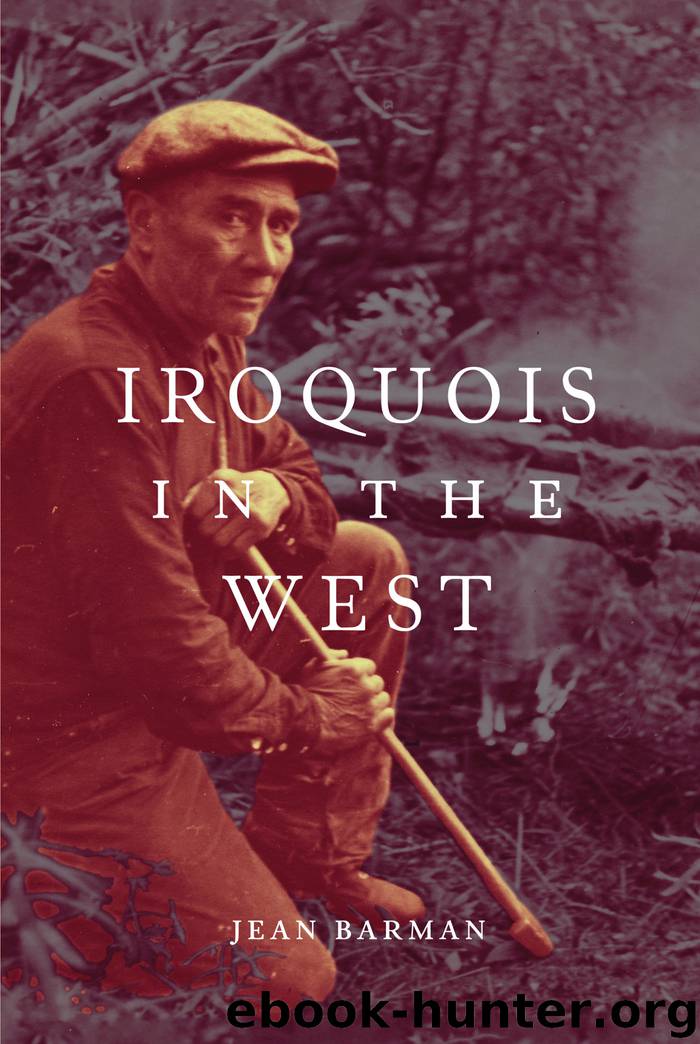Iroquois in the West by Jean Barman

Author:Jean Barman
Language: eng
Format: epub
Publisher: MQUP
Figure 6.3
Artist Frederick Alexcee with his wife, Angelina, and child, ca. 1900. The painting in the lower right is Alexcee’s “Pole Raising at Fort Simpson” (ca. 1900), auctioned by Heffels in 2013, to disappear from view.
It was another missionary presence, that of the Methodists, that nourished Alexcee’s artistry. Beynon described to Barbeau how “Alexcee, while a young man became a crew member on the missionary boat, ‘Glad Tidings,’ first as a stoker and then he became an engineer and was with the steamer until she became a wreck.”64 Constructed in 1884 under the aegis of Methodist missionary Thomas Crosby, who was based in Port Simpson, the Glad Tidings plied the coast doing good works until 1903.65 Entry into the cash economy made it possible for Alexcee to apprentice with Tsimshian maternal relatives as a carver and then to paint and carve what he knew. To do so, he employed various means of supporting his family, including fishing and picking hops.66
William Beynon, who was born in 1888 in Victoria of a Welsh father and a Tsimshian mother and made his life at Port Simpson, was among those to take pride in Alexcee’s growing success: “As a boy, I remember his first painting which was of Port Simpson and this was exhibited in Victoria. I would say about forty-five years ago [ca. 1900].”67 Barbeau encountered Beynon while doing fieldwork at Port Simpson in 1915, and he met Alexcee upon watching his coloured lantern slides illustrating Tsimshian stories and legends. Returning to Port Simpson in 1926 with celebrated Canadian painter A.Y. Jackson, Barbeau “brought some of Alexie’s work to the attention of this well-known artist,” who thereupon “bought a water colour sketch showing a few Tsimsyan houses with totem poles.” The next year saw two of Alexcee’s paintings in an exhibition of Northwest Coast art organized jointly by the National Gallery and National Museum of Ottawa that travelled to Toronto and Montreal. The paintings’ style was described in the tenor of the times as “Indian primitive.”68
Alexcee was modest about his success. Upon Beynon informing him that one of his paintings was on display in the National Gallery in Ottawa, Canada’s capital, and showing him the catalogue, he responded, “Oh! well. You tell them that I will paint another for them if they want it. It will cost them $3000.”69 Alexcee knew who he was, and it was not his aim to be a celebrity but rather to be true to himself and his craft. Shortly before Alexcee’s death in 1939, Barbeau described how “he still lives, an old man in his 80’s, entirely out of the art world, fishing salmon in the neighbourhood of Prince Rupert.”70 As Barbeau astutely summed up based on his long association with Beynon and repeated conversations with Alexcee, “His Iroquois blood, plus prolonged experience on a mission boat, were not enough to make him into an artist. For his craftsmanship he was indebted to the Tsimsyan relatives on his mother’s side.”71 In that combination of attributes, as shared
Download
This site does not store any files on its server. We only index and link to content provided by other sites. Please contact the content providers to delete copyright contents if any and email us, we'll remove relevant links or contents immediately.
| Africa | Americas |
| Arctic & Antarctica | Asia |
| Australia & Oceania | Europe |
| Middle East | Russia |
| United States | World |
| Ancient Civilizations | Military |
| Historical Study & Educational Resources |
1787 by Nick Brodie(1206)
The 2012 Story by John Major Jenkins(1045)
Bury My Heart at Wounded Knee by Dee Brown(1031)
Plagues and Peoples by William H. McNeill(892)
Witchcraft in Early North America by Alison Games(889)
Native American Folklore & Traditions by Elsie Clews Parson(853)
Ada BlackJack by Jennifer Niven(845)
Tending the Wild by Anderson M. Kat(842)
Empire of the Summer Moon by S. C. Gwynne(825)
The Wisdom of the Native Americans by Kent Nerburn(805)
0735220891 by Craig Johnson(803)
They Called Me Number One by Bev Sellars(766)
The Truth About Stories by Thomas King(744)
American Serengeti by Dan Flores(743)
The Killing of Crazy Horse by Thomas Powers(728)
An Inca Account of the Conquest of Peru by Ralph Bauer(713)
House of Rain by Craig Childs(704)
Sand Talk by Tyson Yunkaporta(687)
Unworthy Republic by Claudio Saunt(664)
